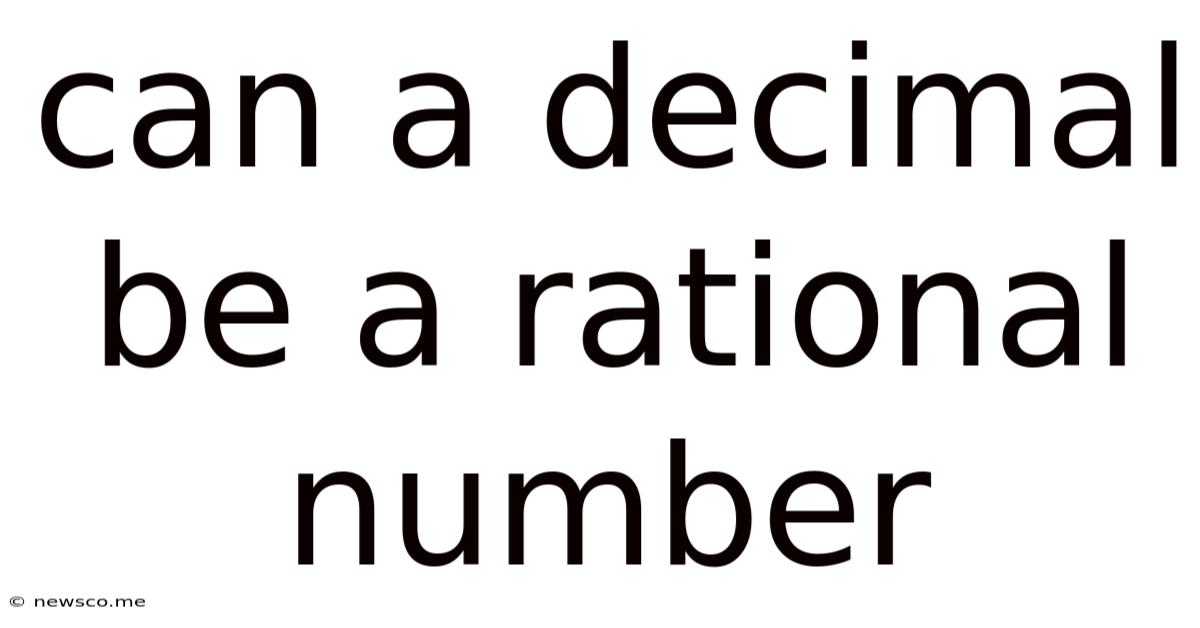Can A Decimal Be A Rational Number
News Co
Apr 03, 2025 · 5 min read

Table of Contents
Can a Decimal Be a Rational Number? Unlocking the Secrets of Rational and Irrational Numbers
The world of numbers is vast and varied, encompassing whole numbers, integers, fractions, and decimals. Understanding the relationships between these different types of numbers is crucial for anyone pursuing mathematics or science. One common area of confusion lies in the distinction between rational and irrational numbers, particularly when considering decimals. This article will delve deep into the question: can a decimal be a rational number? The answer is a resounding yes, but understanding why requires exploring the fundamental definitions of rational and irrational numbers and how decimals fit into the bigger picture.
Understanding Rational Numbers
A rational number is any number that can be expressed as a fraction p/q, where both 'p' and 'q' are integers, and 'q' is not equal to zero. This seemingly simple definition has profound implications. Let's break it down:
- Integers: Integers are whole numbers, including zero and negative whole numbers (...-3, -2, -1, 0, 1, 2, 3...).
- Fraction: A fraction represents a part of a whole. The numerator (p) represents the number of parts we have, and the denominator (q) represents the total number of parts the whole is divided into.
This definition means that any number that can be written as a fraction of two integers is a rational number. This includes:
- Whole numbers: Any whole number can be expressed as a fraction; for example, 5 can be written as 5/1.
- Fractions: These are, by definition, rational numbers (e.g., 3/4, -2/5).
- Terminating decimals: Decimals that end after a finite number of digits are rational.
- Repeating decimals: Decimals that have a pattern of digits that repeats indefinitely are also rational.
Decimals: The Bridge Between Fractions and Rational Numbers
Decimals provide an alternative way to represent fractions. Consider the fraction 1/4. We can easily convert this to a decimal by performing the division: 1 ÷ 4 = 0.25. This decimal, 0.25, terminates after two digits. Since 0.25 is equivalent to the fraction 1/4, and 1 and 4 are integers, 0.25 is a rational number.
This highlights the crucial connection between decimals and rational numbers: many decimals represent rational numbers. The key lies in the ability to express the decimal as a fraction of two integers.
Terminating Decimals and Rational Numbers
Terminating decimals are those that end after a finite number of digits. Examples include 0.75, 0.5, and 0.125. These are easily converted into fractions:
- 0.75 = 75/100 = 3/4
- 0.5 = 5/10 = 1/2
- 0.125 = 125/1000 = 1/8
As you can see, each terminating decimal can be expressed as a fraction with integer numerator and denominator. Therefore, all terminating decimals are rational numbers.
Repeating Decimals and Rational Numbers
Repeating decimals are those that have a pattern of digits that repeats infinitely. These are often represented by placing a bar over the repeating digits. For example:
- 0.333... (or 0.3̅) represents 1/3
- 0.142857142857... (or 0.142857̅) represents 1/7
Converting repeating decimals to fractions requires a bit more algebraic manipulation, but it's always possible. The method involves setting the decimal equal to 'x', multiplying by a power of 10 to shift the repeating block, subtracting the original equation, and solving for 'x'. This process demonstrates that all repeating decimals are rational numbers.
Irrational Numbers: The Exception to the Rule
Irrational numbers, in contrast to rational numbers, cannot be expressed as a fraction of two integers. Their decimal representations are non-terminating and non-repeating. This means the digits continue indefinitely without any discernible pattern.
Famous examples of irrational numbers include:
- π (pi): The ratio of a circle's circumference to its diameter. Its decimal representation is approximately 3.14159265359... but continues infinitely without repeating.
- e (Euler's number): The base of the natural logarithm. Its decimal approximation is 2.71828... and also continues infinitely without repeating.
- √2 (the square root of 2): This number, when squared, equals 2. Its decimal representation is approximately 1.41421356..., and it's also non-terminating and non-repeating.
The existence of irrational numbers highlights the richness and complexity of the number system. They are fundamentally different from rational numbers because they cannot be represented as a simple fraction.
Distinguishing Rational from Irrational Decimals
The key to identifying whether a decimal represents a rational or irrational number lies in its representation:
- Terminating decimals: Always rational.
- Repeating decimals: Always rational.
- Non-terminating and non-repeating decimals: Always irrational.
Practical Applications and Significance
Understanding the difference between rational and irrational numbers has practical applications in various fields:
- Computer Science: Representing rational numbers in computers is often simpler than representing irrational numbers, which require approximation.
- Engineering: Many engineering calculations involve rational numbers, enabling precise measurements and calculations.
- Physics: While irrational numbers like π appear in physics equations, they are often approximated for practical calculations.
Conclusion: The Rationality of Decimal Numbers
To reiterate the central theme, many decimals are rational numbers. Any decimal that either terminates or repeats can be expressed as a fraction of two integers, fulfilling the definition of a rational number. Only non-terminating, non-repeating decimals fall into the category of irrational numbers. This distinction is fundamental to understanding the structure and properties of the number system and is crucial in numerous mathematical and scientific applications. By mastering the concepts of rational and irrational numbers and their decimal representations, you gain a deeper appreciation for the intricate world of mathematics. The seemingly simple decimal point opens a window into a vast and fascinating landscape of numerical possibilities.
Latest Posts
Related Post
Thank you for visiting our website which covers about Can A Decimal Be A Rational Number . We hope the information provided has been useful to you. Feel free to contact us if you have any questions or need further assistance. See you next time and don't miss to bookmark.